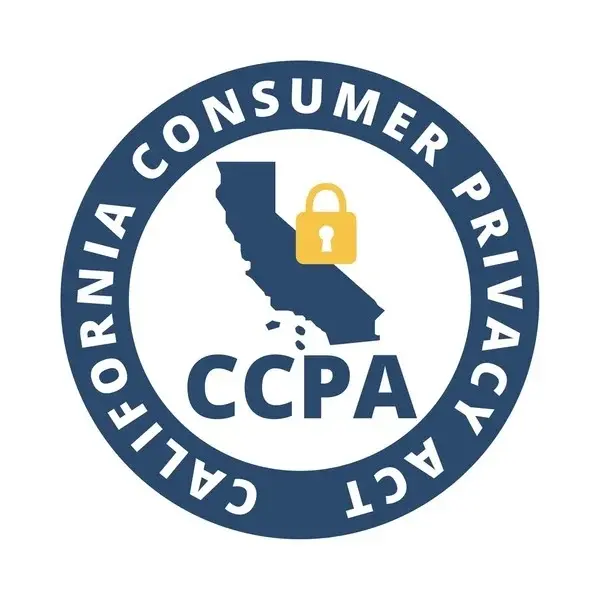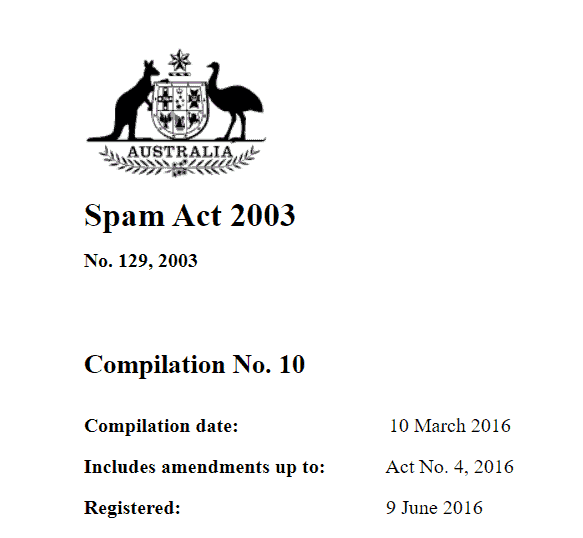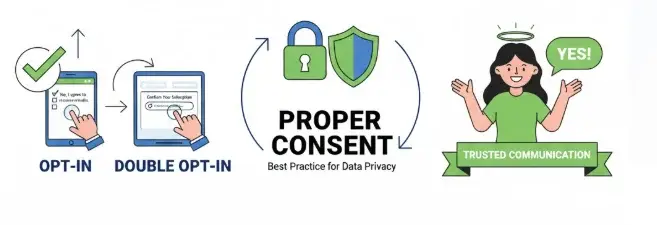Did you know that violating email marketing regulations can cost your business up to $51,744 per email? Whether you’re sending newsletters to 100 subscribers or running campaigns for thousands, understanding email marketing compliance isn’t optional anymore. In this guide, you’ll discover exactly which laws apply to your business, how to stay compliant, and why following these rules actually helps you build stronger relationships with your customers.
What is Email Marketing Compliance and Why Does It Matter?
Email marketing compliance means following the legal rules and regulations that govern how businesses can send commercial emails to customers and prospects. These laws exist to protect people from spam, unwanted messages, and misuse of their personal information.
Why should you care? Three big reasons:
First, compliance builds trust. When you ask for permission before emailing someone and make it easy for them to unsubscribe, you show respect for their inbox and privacy. This creates stronger, more positive relationships with your audience.
Second, it protects your customers. Email marketing regulations ensure people have control over what messages they receive and how their personal data is used. Nobody likes spam, and these laws help keep inboxes cleaner.
Third, non-compliance can destroy your business. The penalties are severe, ranging from thousands to millions of dollars in fines. Plus, violating email laws damages your reputation, gets you blacklisted by email providers, and can result in legal action from angry recipients.
Major Global Email Marketing Regulations You Need to Know
Different countries have different rules for email marketing. If you send emails internationally, you need to understand the laws in each region where your subscribers live. Here are the most important ones:
CAN-SPAM Act (United States)

The CAN-SPAM Act is the primary law governing commercial emails in the United States. If you send marketing emails to people in the U.S., you must follow these rules, regardless of where your business is located.
The law outlines seven key requirements, often called the “7 Commandments of CAN-SPAM”:
Don’t use false or misleading header information. Your “From,” “To,” “Reply-To,” and routing information must be accurate and identify who actually sent the message.
Don’t use deceptive subject lines. Your subject line must accurately reflect the content of your email.
Identify the message as an ad. You need to disclose clearly that your email is an advertisement, though the law gives you flexibility in how you do this.
Tell recipients where you’re located. Include your valid physical postal address in every email.
Tell recipients how to opt out. Provide a clear and easy way for people to unsubscribe from future emails.
Honor opt-out requests promptly. You must process unsubscribe requests within 10 business days.
Monitor what others are doing on your behalf. Even if you hire another company to handle your email marketing, you’re still legally responsible for compliance.
GDPR (General Data Protection Regulation – European Union)

GDPR is one of the world’s strictest and most comprehensive data privacy laws. It applies to any business that processes personal data of people in the European Union, no matter where that business is located.
For email marketing, GDPR requires explicit, clear consent before you can send promotional emails. This means:
You must get affirmative consent. Pre-checked boxes don’t count. People need to actively opt in by checking an unticked box or clicking a confirmation link.
Your consent request must be clear and separate from other terms. You can’t hide your email opt-in within a long privacy policy.
People must know exactly what they’re consenting to. Explain clearly what types of emails they’ll receive and how often.
GDPR also grants EU residents several important rights regarding their personal data. These include the right to access their data, correct inaccurate information, delete their data (the “right to be forgotten”), restrict how you process their data, and receive a copy of their data in a portable format.
The penalties for GDPR violations are enormous. Fines can reach up to 20 million euros or 4% of your global annual revenue, whichever is higher.
CASL (Canada’s Anti-Spam Legislation)

CASL is Canada’s anti-spam law and is considered one of the strictest in the world. If you send commercial electronic messages to Canadians, CASL applies to you.
CASL requires either explicit or implied consent before sending marketing emails. Explicit consent means the person clearly agreed to receive your emails. Implied consent can come from existing business relationships, but it has strict time limits and conditions.
Every commercial email must clearly identify who’s sending it, provide accurate contact information, and include a simple unsubscribe mechanism that works for at least 60 days.
CASL violations carry serious penalties. Individuals can be fined up to $1 million per violation, and businesses can face fines up to $10 million per violation.
CCPA and CPRA (California, USA)

The California Consumer Privacy Act (CCPA) and its enhanced version, the California Privacy Rights Act (CPRA), give California residents extensive control over their personal information.
If your business collects personal information from California residents and meets certain thresholds (like annual revenues over $25 million or data from 100,000+ consumers), these laws apply to you, even if you’re not based in California.
Key rights under CCPA/CPRA include the right to know what personal data you’re collecting, the right to delete personal data, the right to opt out of the sale or sharing of personal data, and the right to correct inaccurate personal information.
For email marketing specifically, you must provide clear notices about data collection and honor opt-out requests for the sale or sharing of personal information.
Spam Act 2003 (Australia)

Australia’s Spam Act regulates commercial electronic messages sent to Australian addresses. The law requires consent (either express or inferred), accurate sender information, and a functional unsubscribe option in every commercial message.
Express consent means someone explicitly agreed to receive your emails. Inferred consent can come from business cards, existing business relationships, or conspicuous publication of an address with no indication the person doesn’t want marketing emails.
PECR (Privacy and Electronic Communications Regulations – UK)

The UK has its own set of rules for electronic marketing through PECR, which works alongside UK GDPR. PECR requires explicit consent for marketing emails to individuals, though different rules apply for business-to-business emails.
You must provide clear information about your identity and make it easy for recipients to opt out at any time, free of charge.
How to Ensure Your Email Marketing is Compliant

Now that you understand the major laws, here’s exactly how to make sure your email marketing stays on the right side of regulations:
Get Proper Consent
Always use the opt-in method for collecting email addresses. This means people must actively choose to receive your emails by checking an unticked box, clicking a button, or confirming through a double opt-in process.
Never purchase email lists. Buying lists means you don’t have proper consent from those people, and it violates most email marketing regulations.
Keep records of when and how people gave consent. If someone ever disputes receiving your emails, you need proof they agreed.
Make your signup forms crystal clear. Tell people exactly what they’re signing up for, including what types of emails they’ll receive and how often.
Be Honest and Transparent
Your subject lines must accurately reflect your email content. Never use clickbait or misleading phrases just to boost open rates.
Use accurate “From” information. Recipients should immediately recognize who sent the email.
Clearly identify your emails as advertisements when appropriate. You don’t need to stamp “ADVERTISEMENT” across the top, but the commercial nature should be obvious.
Make Unsubscribing Easy
Every marketing email must include a clear, visible unsubscribe link. Don’t hide it in tiny text or make it blend into the background.
The unsubscribe process should take no more than two clicks. Don’t force people to log in or jump through hoops to opt out.
Process unsubscribe requests within 10 business days maximum. Most email marketing platforms handle this automatically.
Don’t charge fees for unsubscribing or require people to do anything except click and confirm.
Include Contact Information
Add your valid physical mailing address to every email. This is required by CAN-SPAM and shows transparency.
Many businesses place this information in the email footer along with unsubscribe links and privacy policy links.
Protect User Data
Store personal information securely using encryption and access controls. Only give access to people who absolutely need it.
Have processes in place to handle data subject requests. If someone asks to see, correct, or delete their data, you need to respond quickly and appropriately.
Don’t share or sell email addresses without explicit permission. Under laws like GDPR and CCPA, this requires separate, specific consent.
Regularly audit your data practices to ensure you’re only collecting and storing what you actually need.
Link to Your Privacy Policy
Every marketing email should include a link to your privacy policy, typically in the footer. Your privacy policy should clearly explain what data you collect, how you use it, who you share it with, and how people can exercise their rights.
Keep your privacy policy up to date and make sure it’s written in plain language that normal people can understand.
Vet Third-Party Services
If you use email marketing platforms, CRM systems, or other third-party tools, make sure they’re compliant with relevant regulations.
Read their terms of service and data processing agreements carefully. Understand what they do with your subscribers’ data.
Choose reputable providers that take compliance seriously and offer features like easy unsubscribe management, consent tracking, and data security.
Remember, even if a third party handles your emails, you’re still responsible for compliance.
The Real Cost of Non-Compliance

Ignoring email marketing regulations isn’t just risky, it can be catastrophic for your business. The penalties are severe and getting stricter:
Under CAN-SPAM, violations can cost up to $51,744 per email. If you send a non-compliant email to 1,000 people, that’s a potential $51 million penalty.
GDPR fines can reach 20 million euros or 4% of your global annual turnover, whichever is higher. Major companies have faced fines in the hundreds of millions.
CASL penalties go up to $10 million per violation for businesses and $1 million for individuals.
Beyond fines, non-compliance damages your reputation. Word spreads quickly when a company spams people or mishandles personal data. You’ll lose customer trust, face negative publicity, and potentially deal with class-action lawsuits.
Email service providers and ISPs also take compliance seriously. If you consistently violate regulations, your domain can get blacklisted, meaning your emails won’t reach anyone, compliant or not.
Technical Best Practices for Email Authentication

Beyond legal compliance, implementing proper email authentication protocols helps ensure your emails actually reach inboxes and aren’t flagged as spam or phishing attempts.
SPF (Sender Policy Framework)
SPF is a DNS record that lists which mail servers are authorized to send emails on behalf of your domain. When an email arrives, the receiving server checks the SPF record to verify the sender is legitimate.
Setting up SPF prevents spammers from forging emails that appear to come from your domain.
DKIM (Domain Keys Identified Mail)
DKIM adds a digital signature to your emails using cryptographic authentication. The receiving server can verify this signature to confirm the email wasn’t altered during transmission and actually came from your domain.
DKIM helps prevent email tampering and improves deliverability.
DMARC (Domain-based Message Authentication, Reporting, and Conformance)
DMARC builds on SPF and DKIM by telling receiving servers what to do if an email fails authentication checks. You can set policies to quarantine or reject suspicious emails.
DMARC also provides reporting so you can monitor who’s sending emails using your domain and catch unauthorized use quickly.
Together, these three protocols (SPF, DKIM, and DMARC) form a strong foundation for email authentication. Most modern email marketing platforms help you set these up, and they’re increasingly required by major email providers.
Quick Reference: Email Marketing Compliance Checklist
| Requirement | Action |
|---|---|
| Consent | Get explicit opt-in before sending |
| Subject Lines | Keep accurate and non-deceptive |
| Unsubscribe | Include clear, easy opt-out option |
| Address | Add valid physical mailing address |
| Data Security | Protect personal information properly |
| Privacy Policy | Link to clear, updated policy |
Conclusion: Compliance is Good Business
Understanding and following email marketing regulations might seem complicated at first, but it’s absolutely essential for running a successful, sustainable email marketing program. These laws exist for good reasons: they protect consumers, reduce spam, and create a healthier digital ecosystem for everyone.
The good news is that compliance and good marketing go hand in hand. When you get proper consent, respect people’s preferences, and make it easy to opt out, you build an engaged audience that actually wants to hear from you. These people are far more likely to open your emails, click your links, and become customers.
Start implementing these practices today. Audit your current email marketing processes, fix any compliance gaps, and build systems that keep you on the right side of the law automatically. Your subscribers will appreciate it, your deliverability will improve, and you’ll sleep better knowing you’re not risking massive fines.
Remember, email marketing compliance isn’t a one-time task. Laws evolve, new regulations emerge, and your business changes. Make compliance an ongoing priority, stay informed about regulatory updates, and regularly review your practices.
